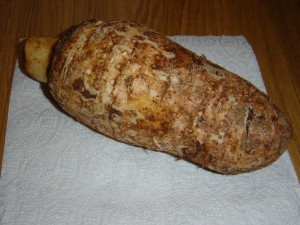The Taro used in this recipe is the root (tuber) brownish one. Rich in calcium and iron, root Taro is an excellent source of energy and fibre. The traditional way we cook it with tahini sauce and chickpeas make it an ideal meal for vegans or non-vegans. This dish can be prepared in advance and re-heated, it also freezes well.

Taro Root (Colocasia)
If you wish to know more about the benefits of Taro, I included 3 websites at the end of the recipe.
Which one to buy?
Select a Taro that is firm and has no traces of mould. I normally go for the large ones (weighing about 1 kg / 2¼ lb) because they are creamier and richer than the small ones.
Word of advice
Root Taro contains calcium oxalate, a substance that can irritate both mouth and skin. So never taste the taro raw and preferably wear gloves when peeling raw Taro.
Serves: 2-3
Ingredients
- 50 g / 2 oz chickpeas soaked overnight in water with ¼ tsp bicarbonate of soda or the same amount of tinned chickpeas
- 550 g / 1¼ lb Taro / Colocasia
- 450 g / 1lb onions peeled and quartered
- 3 tbsp vegetable oil
- 300ml/ vegetable stock
- Salt & freshly milled black pepper
Tahini sauce
- 2 cloves of garlic peeled and crushed to a paste
- 85 ml / 3 fl oz tahini paste
- 60 ml / 2¼ fl of lemon juice or for a sweet and sour taste, use half orange juice, half lemon juice
- 100 ml / 3½ fl oz water
Method
1. If you are starting with the chickpeas you soaked overnight, rinse them under cold water, transfer to a small saucepan, cover generously with water and add ½ tsp salt. Bring to the boil using high heat and removing any scum that forms on the surface. Once you’ve finished, reduce to a medium heat, cover and simmer for roughly 40 minutes, (you know the chickpea is cooked when you can insert a fork). Check once or twice whether you need topping up with hot water. The tinned chickpeas can simply be drained and used as is in section 3.
2. Peel the Taro / Colocasia protecting your hands with gloves, the skin is usually tougher than potato, so you need a sharp knife. Remove all the brownish muddy skin until you get to the firm, white flesh. Then halve the taro lengthwise and slice each half across into about 1 cm / ½ inch thick slices then into 1 cm cubes. Rinse them under tap water, then pat dry them thoroughly. Heat up 1 ½ tbsp of the oil in a pan and fry the Taro / Colocassia cubes until golden. Drain excess fat on a kitchen paper.
3. Heat up the remaining oil in a medium sized saucepan and sauté the onions. Drain chickpeas and mix in, cook until onions are soft. Now, add the fried Taro / Colocasia, season with salt and freshly milled black pepper, give the mixture a good stir, then pour in the stock. Bring to the boil, cover and let it simmer for about 7 minutes. Now, take the lid off and continue the cooking for another 5 minutes, by which time the Colocasia should be tender, not mushy and all the liquid has been absorbed. Stir in the prepared tahini sauce, mix it in thoroughly, give it 3 minutes to gently bubble, then switch off the heat.
4. There are 2 ways to serve: hot with plain rice which makes it a meal in itself. You can also serve it at room temperature with Lebanese bread or just on its own.
Suggested websites
http://www.nutritiondata.com/facts/vegetables-and-vegetable-products/2674/2
http://www.fao.org/wairdocs/x5425e/x5425e01.htm
http://www.thaifoodandtravel.com/features/taro.html

